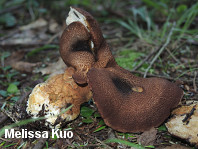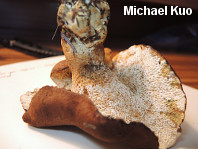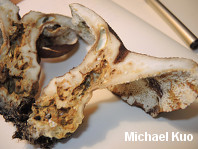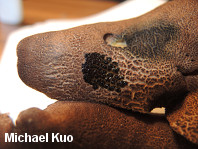Albatrellus pes-caprae (MushroomExpert.Com) (original) (raw)
Albatrellus pes-caprae
[ Basidiomycota > Russulales > Albatrellaceae > Albatrellus . . . ]
by Michael Kuo
This dark, scaly Albatrellus grows under conifers and features a pore surface that differs from the "typical" Albatrellus pore surface: instead of featuring small, roundish pores, Albatrellus pes-caprae boasts large, angular pores that approach being diamond-shaped or hexagonal. Albatrellus ellisii is similar (it too is a scaly-capped, large-pored, conifer associate), but it is more yellow, develops greenish stains, and has amyloid hyphae.
The North American distribution of Albatrellus pes-caprae is odd, especially for a mycorrhizal mushroom: it is fairly common in the Pacific Northwest and in California--as well as an area extending from the southeastern United States to about Pennsylvania. It was originally named in Europe (Persoon, 1818), where it is widespread; our North American version (versions?) may be phylogenetically distinct.
Polyporus pes-caprae is a former name; Albatrellus/Scutiger oregonensis is a synonym. Field guides sometimes feature the species epithet without the hyphen, as "pescaprae." Audet (2010) placed this species, along with Albatrellus ellisii, in the genus Scutiger. Audet created six new genera and resurrected several more in the process of breaking up the genus Albatrellus, but my reading of his LSU and ITS phylograms makes most of the new genera unnecessary; Albatrellus, Jahnoporus, and Audet's newly erected Xanthoporus suffice perfectly well to delineate relationships within the sampled taxa.
Description:
Ecology: Mycorrhizal with conifers; usually growing alone or in small groups; summer and fall; distributed in North America from California to the Pacific Northwest, and from the southeastern United States northward to Ohio and Pennsylvania. The illustrated and described collection is from Ohio.
Cap: 8-15 cm across; more or less circular in outline, or kidney-shaped; broadly convex, flat, or irregular; occasionally with several caps arising from a single stem; dry; cracked and scaly, especially over the center; dark brown; staining black in places with old age; the margin somewhat tucked under.
Pore Surface: Descending the stem; pores large and angular, 1-2 mm across; white, discoloring brownish to brown or very faintly greenish; tubes 1-3 mm deep.
Stem: 5-8 cm long; 2-4 cm wide; often a little off-center; more or less club-shaped; dry; bald; pale brown; staining darker brown; basal mycelium whitish, also staining.
Flesh: Whitish; unchanging when sliced; fairly soft when fresh; brownish to slightly olive around worm channels.
Odor and Taste: Odor not distinctive, or somewhat foul in old age; taste not distinctive.
Chemical Reactions: KOH instantly black on cap; negative on flesh and pore surface.
Spore Print: Undocumented by me and not found in the literature; probably white.
Microscopic Features: Spores 7-10 x 5-6 µ; nearly amygdaliform or lacrymoid; smooth; hyaline and uniguttulate in KOH; inamyloid. Hyphal system monomitic; hyphae collapsing and poorly defined in KOH, often appearing "cellular," swollen, or gelatinized, but when definable cylindric, 5-10 µ wide, smooth-walled, clamped at most septa, hyaline in flesh, dark brown on cap surface; inamyloid. Clamp connections present.
REFERENCES: (Persoon, 1818) Pouzar, 1966. (Fries, 1821; Saccardo, 1888; Murrill, 1912 [S. oregonensis]; Overholts, 1953; Smith, Smith & Weber, 1981; Arora, 1986; Breitenbach & Kränzlin, 1986; Gilbertson & Ryvarden, 1986; Lincoff, 1992; Audet, 2010.) Herb. Kuo 07171502.
This site contains no information about the edibility or toxicity of mushrooms.
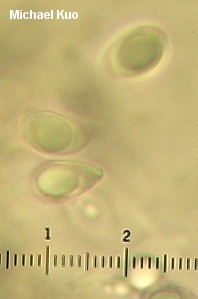
Spores
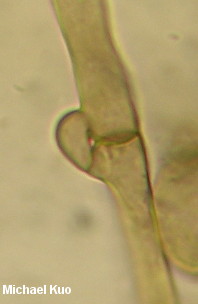
Clamp connection
© MushroomExpert.Com
